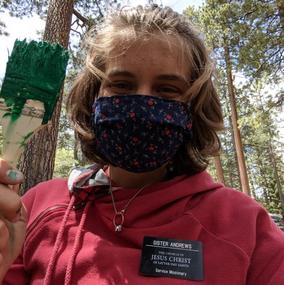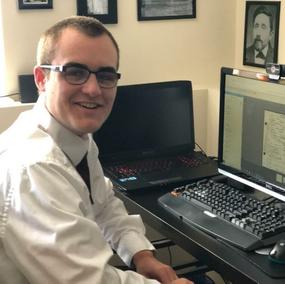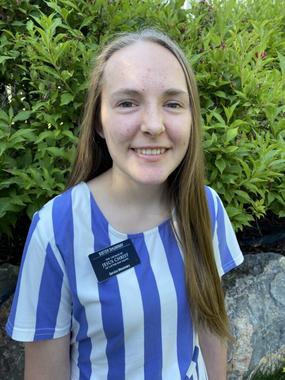- Bekki Andrews 1
- Bekki Andrews 2
- Bekki Andrews 3
- Bekki Andrews 4
- Josh Scott 1
- Josh Scott 2
- Josh Scott 3
- Ivy Shumway 1
- Ivy Shumway 2
- Ivy Shumway 3
| Temple Square is always beautiful in the springtime. Gardeners work to prepare the ground for General Conference. © 2012 Intellectual Reserve, Inc. All rights reserved. | 1 / 2 |
This story appears here courtesy of TheChurchNews.com. It is not for use by other media.
By Sydney Walker, Church News
When 20-year-old Sister Bekki Andrews learned she would have to leave the Minnesota Minneapolis Mission early because of COVID-19 precautions and her asthma, she was devastated.
The young full-time missionary was 12 months into her service when she returned home in March to West Covina, California.
Before Sister Andrews was released, her stake president suggested she consider transferring to a service mission. “I didn’t even know what a service mission was,” she admitted.
After praying about it and talking with a sister in her ward who started as a teaching missionary and had recently begun a service mission, Sister Andrews decided to give it a try. Her reassignment was approved by the Quorum of the Twelve Apostles.

Bekki Andrews 2
Sister Bekki Andrews, a Church service missionary, takes a selfie while helping repaint cabins at a Church-owned camp in Big Bear, California, on May 30, 2020. Photo courtesy of Bekki Andrews, courtesy of Church News.All rights reserved.Now five months into her service mission, some of Sister Andrews’ activities have included serving at the bishops’ storehouse, distributing food with The Salvation Army, repainting cabins at a Church-owned camp, reading the Book of Mormon with ward members, joining Zoom lessons with teaching missionaries, sewing face masks, practicing piano, doing family history, learning Spanish and making birthday cards for Primary children.
“She jumped right in and she was just so enthusiastic about serving,” said Elder Rod Hulet, service mission leader in the California Arcadia Service Mission Area. “The creativity that she has come up with in order to really serve full-time while being at home — it’s just amazing to us the way she has filled out her missionary schedule as a service missionary, even under COVID-19.”
Sister Andrews said her service mission has given her confidence. “But not just confidence in myself — confidence that when God closes one door, He opens another. … No matter where I go, the Lord is going to provide a way for me to participate in His plan.”
Elder W. Mark Bassett, a General Authority Seventy and assistant executive director in the Missionary Department who oversees the Church’s service missionary program, said he hopes every worthy missionary who returns home for health or other reasons, and is still capable of serving, accepts the opportunity to transfer to a service mission.
“When they realize that this is not secondary, but it’s a transfer, and they can go from their area serving in Minnesota, for example, and go home and transfer to a service mission and still serve the community, they feel more fulfilled,” Elder Bassett said.
“For those that have accepted that opportunity, I know it’s been a great blessing” — for both the missionary and the community, he added.
What Are Service Missionaries?
Young full-time missionaries who return home early due to health challenges — during the pandemic or at any point in their service — are not the only candidates for a service mission.
Worthy young men (ages 18 to 25) and young women (ages 19 to 25) who are unable to serve a teaching mission for physical, mental, emotional or other reasons may be called to a service mission, Elder Bassett explained.
Service missionaries live at home and serve locally under the ecclesiastical direction of their stake president. Their assignments are customized to their capabilities, needs and interests and they serve as close to full-time as their circumstances allow. Often, service mission leaders (similar to a mission president and his companion) are called to support service missionaries in their area and identify service opportunities.
As of Aug. 18, there are a total of 1,133 service missionaries throughout the United States and Canada and two in the United Kingdom. The service missionary program recently expanded to the U.K. and Ireland, and “we expect it will grow beyond that,” Elder Bassett said.
The First Presidency announced changes to the service missionary program beginning in January 2019, and now all young missionary candidates follow the same recommendation process. Under the direction of the First Presidency and the Quorum of the Twelve Apostles, each prospective missionary who qualifies receives a call that best suits him or her.
“Every young man or young woman that has a desire to serve God can do so,” Elder Bassett said. “And their call comes from a prophet.”
Though many service missionaries’ assignments have been affected by the ongoing pandemic, the missionaries are responding “very positively,” he said. “They’re battling through COVID-19 and this environment and really thriving.”
‘Thriving’ in Adjusted Service Assignments
Elder Josh Scott, 19, a service missionary in Hebron, Kentucky, has indexed more than 10,100 names since he began his service mission six months ago.
But family history wasn’t his initial service assignment. For about a month, Elder Scott served at the Mary Rose Mission, a Catholic organization in Florence that serves food to the needy; performed proxy ordinances at the Louisville Kentucky Temple and served at the National Underground Railroad Freedom Center, a museum in Cincinnati where he started learning how to index.
When all three locations closed due to the pandemic, Elder Scott shifted his focus to family history work and indexing at home.

Josh Scott 1
Elder Josh Scott, a Church service missionary, smiles while indexing at his home in Hebron, Kentucky, in August 2020. Elder Scott has indexed 10,100 names in six months, as of Aug. 17. Photo by Rachael Scott, courtesy of Church News.All rights reserved.“When I first started indexing, I was a little nervous,” said Elder Scott, who has high-functioning autism. “I wasn’t really sure how it was going to work. Then I started doing it more, and it was easy.”
Of his 10,000-plus indexed names, Elder Scott said, “It makes me feel accomplished, knowing that I’m helping those beyond the veil. … If I hadn’t started indexing, who knows where I would be today? Who knows how my mission would have turned out?”
He recently made a video explaining what indexing is and how to index and he has even taught indexing at service missionary trainings. “I’ve been able to uplift others through sharing my testimony about how Heavenly Father needs everyone to be indexing,” he said.
Elder Paul and Sister Debbie Beck, service mission leader advisors for the North America Northeast Area, worked with Elder Scott at the beginning of his mission as service mission leaders in the Ohio Cincinnati Service Mission Area. They previously presided over the Arizona Phoenix Mission (2008-2011).
“He started as very timid, unsure of anything he was asked to do. But the desire — you could just see [it] was burning inside of him to serve the Savior,” said Sister Beck of Elder Scott. “The transformation that took place in this young man in six months’ time has been a miracle. It’s just been amazing to watch the growth that he has made.”
Elder Scott and all service missionaries are emulating the Savior’s example, Elder Beck added. “The Savior did two things in his ministry. Number one, he served, and number two, he taught. … Service missionaries are every bit as important — if not more important — than teaching missionaries.”
‘I Can Serve and Make a Difference’
Serving a teaching mission was Sister Ivy Shumway’s lifelong dream. But as she grew closer to mission age, she started having health challenges.
Two strokes — about a year apart — sent her to the hospital, and she learned she has a metabolic disorder that causes strokes. After each stroke, she went through months of intensive physical, occupational, vision and speech therapy so her body and brain could relearn basic functions.

Ivy Shumway 3
Sister Ivy Shumway, a Church service missionary, smiles for a photo in July 2020. Despite her health challenges, Sister Shumway is finding creative ways to serve. Photo by Marion Shumway, courtesy of Church News.All rights reserved.“I still wanted to serve a mission, so I worked with my ward and stake leaders and submitted my papers,” said Sister Shumway, 21, of Alpine, Utah. She received a call to a service mission and began her mission in September 2019.
Sister Shumway’s assignments included serving at the bishops’ storehouse in Lindon and serving as an ordinance worker in the Mount Timpanogos Utah Temple. About six weeks into her mission, and then again about five months later, she suffered strokes that sent her back to the hospital and through therapy.
“It was really frustrating because I just wanted to serve and be a missionary,” she said. “I worked really hard at all my therapies so I would be strong enough to keep serving.”
Though she is currently in good health, the COVID-19 pandemic has prevented her from returning to her previous assignments. She continues to find service opportunities, such as making blankets for Primary Children’s Hospital in Salt Lake City, where she received a blanket of her own as a patient. Recently she has been assembling care kits for children with cancer and their families.
“I have come to know that even with my challenges I can serve and make a difference,” she said. “We all have different abilities and situations, but there is something that each of us can do to build Heavenly Father’s kingdom.”
Sister Shumway’s father, Marion Shumway, added, “We know how big Ivy’s heart is and how much she loves our Heavenly Father. We’re just thrilled that she gets a chance to serve, even though it’s different than what she always dreamed of. … We love to see the way she gets to share her love with others through the service that she can do as a service missionary.”
To learn more about the Church’s service missionary program, visit ChurchofJesusChrist.org/service-missionary.
Copyright 2020 Deseret News Publishing Company